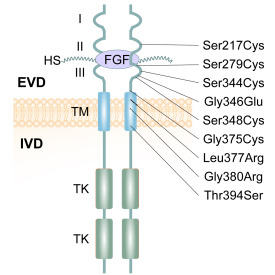
Advances in the mechanism and therapies of achondroplasia


Achondroplasia (ACH), is the prevailing type of genetic dwarfism in humans, caused by mutations in fibroblast growth factor receptor 3 (FGFR3) that are inherited in an autosomal dominant manner. FGFR3 is mainly expressed in condensed mesenchyme, chondrocytes, and mature osteoblasts and osteoclasts, in which it regulates the formation, development, growth, and remodeling of the skeletal system. Mutations in FGFR3 causing ACH result in enhanced FGFR3 signaling through combined mechanisms including enhancing FGF dimerization and tyrosine kinase activity and stabilizing FGF receptors. In ACH, suppression of the proliferation and maturation of chondrocytes in the growth plate leads to a notable reduction in growth plate size, trabecular bone volume, and bone elongation through a profound enhancement of FGFR3 signaling. This review aims to comprehensively outline the cellular and molecular mechanisms contributing to the pathological process of ACH and its potential therapeutic interventions.
